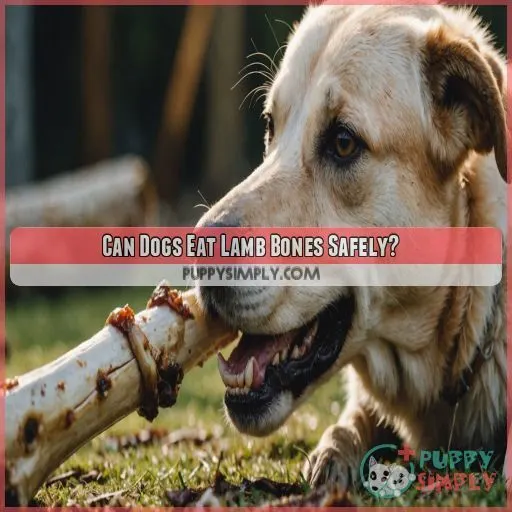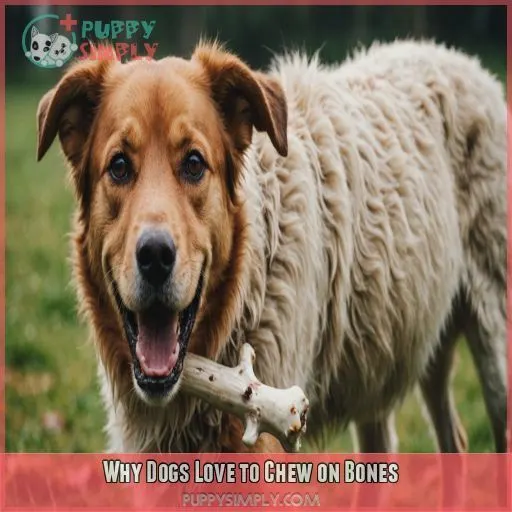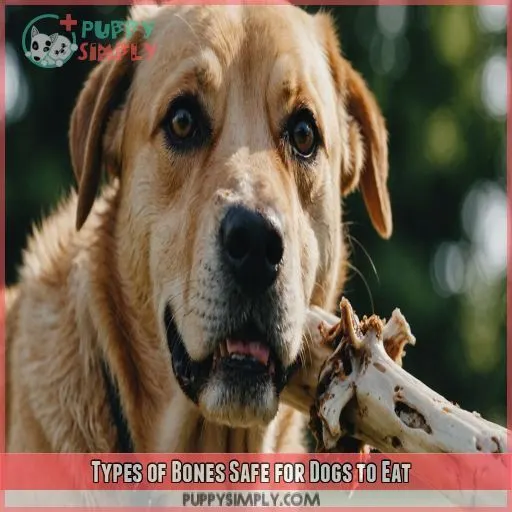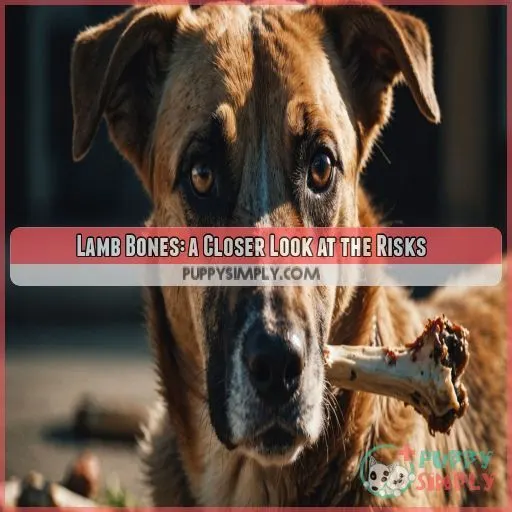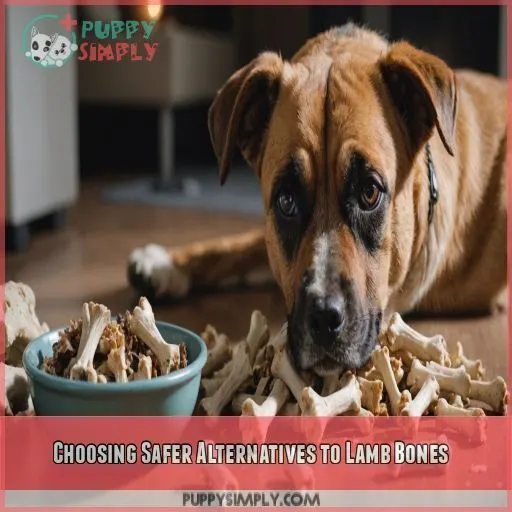This site is supported by our readers. We may earn a commission, at no cost to you, if you purchase through links.
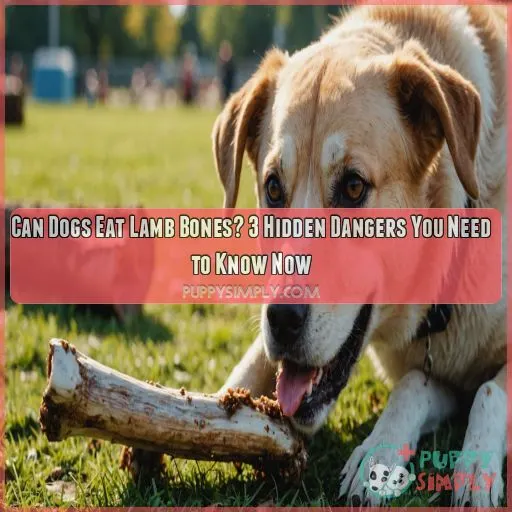 Can dogs eat lamb bones? The answer is a resounding "be cautious."
Can dogs eat lamb bones? The answer is a resounding "be cautious."
Raw lamb bones can harbor bacteria, while cooked ones can splinter and cause harm.
If your dog swallows a small lamb bone, it can get stuck in their throat or digestive system. Even large bones can damage their teeth.
You want to keep your pup safe, so it’s best to steer clear of lamb bones altogether.
Instead, consider safer alternatives like high-quality dog food, toys, and chews.
Want to know what else you can do to keep your dog safe and happy?
Table Of Contents
- Key Takeaways
- Can Dogs Eat Lamb Bones Safely?
- Why Dogs Love to Chew on Bones
- Types of Bones Safe for Dogs to Eat
- What Happens if My Dog Eats a Bad Bone?
- Lamb Bones: a Closer Look at the Risks
- Choosing Safer Alternatives to Lamb Bones
- Frequently Asked Questions (FAQs)
- Can a dog eat a cooked lamb bone?
- What kind of bones can dogs eat?
- Is lamb toxic to dogs?
- Are lamb necks safe for dogs?
- Are lamb bones ever safe for dogs to eat?
- Why are dogs drawn to chewing bones?
- What bones are safe for my dog to chew?
- What are the signs my dog has eaten a bad bone?
- Whats a safer alternative to lamb bones?
- Conclusion
Key Takeaways
- You’re probably tempted to give your dog a lamb bone, but hold off – they can be super hazardous! Raw lamb bones can harbor bacteria, while cooked ones can splinter and cause harm, so it’s best to steer clear of them altogether.
- If you’re looking for a safer alternative, consider high-quality dog food, toys, and chews that’ll satisfy your dog’s urge to chew without the risks associated with lamb bones. Your pup’s safety is worth the investment!
- Don’t freak out if your dog has already snagged a lamb bone – just act fast! If you catch them in the act, induce vomiting, monitor their health closely, and contact your vet for advice on how to proceed. And remember, it’s always better to err on the side of caution.
- So, what can you give your dog instead? Raw, meaty bones like beef or pork knuckle bones are generally safe, but always choose large, thick ones to avoid choking hazards. And if you’re feeling adventurous, try making your own homemade bone broth for a tasty and nutritious treat!
Can Dogs Eat Lamb Bones Safely?
You’re probably wondering if it’s safe to give your dog lamb bones, and the answer isn’t a simple yes or no. While dogs love to chew on bones, lamb bones can pose some serious health risks, so you need to understand the dangers before making a decision.
Risks of Raw and Cooked Bones
Lamb bones can be a bit tricky. Raw bones can carry Salmonella, while cooked bones can splinter and cause digestive issues or even dental damage. Bone splinters can lead to gastrointestinal obstruction, a serious health risk. Consider safe alternatives, like high-quality dog food or toys and chews, to keep your furry friend safe and happy.
Importance of Veterinary Consultation
Now that you know the risks of raw and cooked bones, it’s time to consult with your vet. They’ll help you figure out the best approach for your furry friend. Here are some things to think about:
- Your dog’s breed, age, and health conditions
- The type and size of bones suitable for your dog
- Vet-approved chews and safe bone alternatives
- Your dog’s dietary needs and potential allergies
- Bone health concerns specific to your dog’s breed or size
Safer Alternatives for Nutrition
So, can dogs eat lamb bones safely? Not really. The risks outweigh any nutritional benefits. But fret not, there are safer alternatives to lamb bones that can provide similar benefits for your dog’s health and chewing urges:
- Bone broth: A tasty, nutritious, and safe alternative.
- High-quality dog food: Packed with essential vitamins and minerals.
- Dog chews and toys: Great for mental stimulation and dental health.
Why Dogs Love to Chew on Bones
You’ve probably caught your dog happily gnawing on a bone at some point, and it’s not hard to see why they love it.
Chewing on bones is a natural instinct for dogs, exercising their jaws and helping to keep their teeth clean.
But before you hand over that lamb bone, you should think about the potential risks and benefits, so you can make an informed decision that’s best for your furry friend.
Natural Instincts and Behavior
You might often wonder why your furry friend loves chewing on bones so much. Here are three reasons behind this instinctive behavior:
- Carnivore Cravings: Dogs are naturally carnivorous, and their taste buds just light up when they get their paws on a juicy bone.
- Chewing Satisfaction: Chewing on bones gives dogs a sense of satisfaction and helps them fulfill their natural urge to chew, especially during puppy teething or when they’re older and need to keep their jaws strong.
- Boredom Buster: Bones provide a fun way to pass the time and keep your dog mentally stimulated, preventing them from chewing on your favorite shoes!
Dental Health and Chewing Benefits
Dogs love to chew on bones, and it’s good for their dental health and jaw strength. Chewing on bones helps keep their teeth clean by scraping away plaque and tartar. It also satisfies their natural urge to chew, which is especially important for teething puppies and older dogs. But not all bones are created equal.
| Type of Bone | Dental Health Benefits | Chewing Safety |
|---|---|---|
| Raw Lamb Bone | Helps scrape off plaque | Safe if supervised |
| Cooked Lamb Bone | Not recommended | Splinter risk |
| Alternatives | Dental chews, toys | Safe, long-lasting |
Nutritional Value of Raw Bones
Raw Bone Nutrition: What’s the Hype?
Raw bones are like nature’s multivitamins for dogs. They’re packed with glucosamine and chondroitin, which support joint health. Bone marrow is rich in calcium, essential for strong bones, and also contains phosphorus and other minerals. Bone broth made from simmering raw bones offers these benefits without the risks of chewing. It’s a win-win for pet safety and health.
Types of Bones Safe for Dogs to Eat
You’re probably wondering which bones are safe for your furry friend to chew on. Well, wonder no more! We’ll guide you through the types of bones that are safe for dogs to eat and help you navigate the do’s and don’ts of bone-giving.
Beef Bones and Safety Guidelines
When choosing beef bones for your dog, go for raw, meaty ones that are large enough for your dog to chew safely. Avoid cooked or brittle bones that can splinter. Store them properly to prevent bacterial growth, and consider alternatives like bone broth or dental chews for a safer, healthier option.
Chicken and Turkey Bones for Dogs
If you’re thinking about giving your dog chicken or turkey bones, stick to raw, meaty bones – they’re safer for your dog to chew on. Avoid cooked bones, as they can splinter and cause harm. Always prioritize bone safety and consult with your vet if you’re unsure.
Pork Bones and Potential Risks
When feeding pork bones to your dog, you need to be careful. Here are three things to keep in mind:
- Raw is safer: Raw pork bones are less likely to splinter than cooked ones.
- Size matters: Choose large, thick bones that won’t easily break apart.
- Cooking increases risk: Cooked pork bones can become brittle and pose a serious health risk to your dog.
Lamb Bones and Hidden Dangers
If you’re thinking about giving your dog lamb bones, there are some safety concerns you need to know about. Here’s a quick rundown:
| Lamb Bone Type | Safety Level |
|---|---|
| Raw Lamb Bones | Caution: may contain bacteria, can cause gastrointestinal obstructions |
| Cooked Lamb Bones | Danger: brittle, easily splinter, can cause digestive tract damage |
| Bone Alternatives | Safe: consider high-quality dog food, toys, and chews for a risk-free treat |
What Happens if My Dog Eats a Bad Bone?
You’re probably worried sick if your dog has gotten their paws on a bad bone, and rightfully so – the consequences can be serious. If your dog has eaten a bad bone, it’s important to act fast and know what to look out for to keep them safe and prevent any potential health problems.
3 Immediate Steps to Take
- Induce vomiting: If you catch your dog in the act, try to induce vomiting to prevent the bone from entering their digestive system.
- Monitor closely: Keep a close eye on your dog for signs of distress, such as vomiting, diarrhea, or lethargy.
- Contact your vet: Reach out to your vet for advice on how to proceed.
- Check for splinters: Inspect your dog’s mouth, throat, and digestive system for any signs of splinters or blockages.
Monitoring Your Dog’s Health
Now that you’ve taken those three immediate steps, it’s time to monitor your dog’s health closely.
Keep an eye out for changes in behavior, appetite, or stool quality.
Schedule regular dog health check-ups with your vet to catch any potential issues early.
If your dog has food allergies or sensitivities, be extra cautious.
Also, make sure their weight management is on track, as excessive weight can worsen bone-related problems.
Regular dog dental care is also really important to prevent further complications.
Lamb Bones: a Closer Look at the Risks
You’re considering giving your dog lamb bones, but before you do, it’s important to know the potential risks involved. From dental damage to bacterial risks, lamb bones can pose some serious health threats to your furry friend, so let’s take a closer look at what you need to know.
Dental Damage and Wear
You’re considering lamb bones for your dog, but beware of dental damage and wear. Chewing on lamb bones can lead to:
- Tooth fractures: Hard bones can crack teeth, causing pain and costly vet bills.
- Worn-down teeth: Regularly chewing on lamb bones can wear down your dog’s teeth, affecting their dental health.
- Gum damage: Sharp bone edges can cut gums, leading to infections.
- Dental work: You may need to shell out for dental work, like extractions or crowns.
Opt for dental-friendly chew toys and teeth cleaning alternatives instead.
Limited Nutritional Value
Let’s talk about lamb bones, the nutritional value is limited. You’re mainly looking at soft tissues like meat and cartilage for any real benefits. A balanced diet is still the best way to provide your dog with all the necessary nutrients. Consider bone broth as a safer alternative for potential bone-related nutrition, or supplements if needed.
Bacterial Risks and Foodborne Illness
When handling lamb bones, you’re exposing yourself and your dog to bacterial risks like Salmonella and E. coli. Raw meat can be a breeding ground for these nasties, so it’s really important to prioritize food safety. Always handle bones safely, and consider alternatives to raw bones to minimize the risk of foodborne illness. Your dog’s health is worth it.
Choosing Safer Alternatives to Lamb Bones
You’re probably thinking, "If lamb bones are off the table, what can I give my dog instead?" Let’s explore some safer alternatives that’ll satisfy your dog’s urge to chew and provide the nutrients they need, without the risks associated with lamb bones.
High-Quality Dog Food Options
Considering safer alternatives to lamb bones? High-quality dog food is a great option. Look for grain-free diets or kibble with wholesome ingredients like chicken or salmon. Check the ingredients to make sure they meet your dog’s nutritional needs. Budget-friendly options are available, and some brands even offer raw or semi-raw formulas. Your dog’s safety is worth the investment.
Toys and Chews for Mental Stimulation
Now that you’ve got the scoop on high-quality dog food, let’s talk about mental stimulation. You can keep your furry friend engaged and satisfied with safer alternatives to lamb bones. Here are some ideas:
- Interactive toys and puzzle feeders that challenge and reward your dog
- Chew toys made from durable, non-toxic materials that withstand aggressive chewing
- Enrichment activities and training treats that keep your dog’s mind and body active
Bone Broth as a Nutritional Supplement
Considering a safer alternative to lamb bones? Try bone broth! Rich in nutrients, it’s a great way to support your dog’s joint health and digestion. You can make your own homemade broth using a simple recipe or choose a store-bought option. Plus, it’s a tasty addition to their kibble. Even puppies can benefit from a warm, comforting bowl of broth.
Frequently Asked Questions (FAQs)
Can a dog eat a cooked lamb bone?
Imagine your pup snapping a cooked lamb bone in two – don’t let that happen! Cooked lamb bones are a no-go for dogs, as they can splinter and cause serious harm. Opt for safer alternatives, like bone broth or toys.
What kind of bones can dogs eat?
You can give your dog raw, meaty bones like beef or pork knuckle bones, but always choose large, thick ones to avoid choking hazards. Never give cooked bones, as they can splinter and cause harm.
Is lamb toxic to dogs?
Don’t cry over spilt milk, but do worry about lamb bones – they’re not toxic, but can be hazardous if cooked or if your dog chokes on them; always consult your vet for safe alternatives and guidance.
Are lamb necks safe for dogs?
When considering lamb necks for your dog, remember that raw is safer than cooked, but still poses risks like gastrointestinal obstructions and salmonella. Consult your vet before offering lamb necks, and explore safer alternatives like bone broth and dental toys.
Are lamb bones ever safe for dogs to eat?
Imagine your furry friend crunching on a lamb bone – sounds harmless, right? Unfortunately, it’s not that simple. Raw lamb bones can pose risks, and cooked ones are a definite no-go due to splintering hazards.
Why are dogs drawn to chewing bones?
Your dog is drawn to chewing bones because it’s in their nature – they’re carnivores! Chewing exercises their jaws, cleans their teeth, and fulfills a natural urge, especially for teething puppies and older dogs.
What bones are safe for my dog to chew?
Raw, meaty bones like knuckle or marrow bones are generally safe for your dog to chew. Avoid cooked or brittle bones that can splinter, and always consult with your vet before introducing new bones to their diet.
What are the signs my dog has eaten a bad bone?
Like a ticking time bomb, a bad bone can wreak havoc on your dog’s insides. Watch for signs like vomiting, diarrhea, lethargy, or difficulty swallowing. If you suspect your dog’s eaten a bad bone, rush them to the vet.
Whats a safer alternative to lamb bones?
Ditch the lamb bones and opt for safer alternatives like bone broth, dental chews, or toys that’ll keep your furry friend satisfied and stimulated without the risks of splintering or digestive damage.
Conclusion
Choosing the right dog treats can be tricky – one wrong choice and your furry friend could be in trouble.
When it comes to lamb bones, it’s best to be cautious.
Can dogs eat lamb bones? The answer is a resounding "be careful."
Steer clear of these hidden dangers and opt for safer alternatives instead.
Your pup’s safety is worth it.

